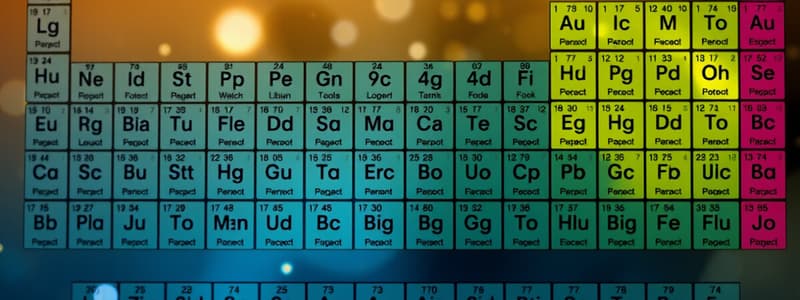Podcast
Questions and Answers
Who created a table of elements in 1869 based on similar chemical properties?
Who created a table of elements in 1869 based on similar chemical properties?
- Strutt
- Mosley
- Mendeleev (correct)
- Ramsay
What is the periodic law?
What is the periodic law?
- The properties of elements are based on atomic mass.
- The properties of elements are periodic functions of their atomic number. (correct)
- Elements with similar properties are arranged randomly.
- None of the above.
What did Mosley modify in Mendeleev's periodic table?
What did Mosley modify in Mendeleev's periodic table?
- Removed noble gases.
- Made it a function of increasing atomic number. (correct)
- Made it a function of increasing atomic mass.
- Organized elements randomly.
What is the atomic number?
What is the atomic number?
What is atomic mass?
What is atomic mass?
Who discovered the first noble gases in 1894?
Who discovered the first noble gases in 1894?
What characteristic do noble gases have?
What characteristic do noble gases have?
How many families are on the periodic table?
How many families are on the periodic table?
What family is known as Family 1 in the periodic table?
What family is known as Family 1 in the periodic table?
What do we call the family in column 17 of the periodic table?
What do we call the family in column 17 of the periodic table?
The family in column 18 contains the least reactive elements known as ______.
The family in column 18 contains the least reactive elements known as ______.
What is an octet?
What is an octet?
Match the following blocks with their sub-orbital characteristics:
Match the following blocks with their sub-orbital characteristics:
Flashcards are hidden until you start studying
Study Notes
Mendeleev and Periodic Table Development
- Mendeleev created the first periodic table in 1869, organizing elements by chemical properties and atomic masses.
- Mosley improved this table by ordering elements by increasing atomic number instead of atomic mass, enhancing predictability for new elements.
Periodic Law
- The periodic law states that the physical and chemical properties of elements vary periodically with their atomic number.
- Elements exhibit similar properties at regular intervals when arranged by atomic number.
Atomic Structure
- Atomic number refers to the number of protons in an atom.
- Atomic mass is the total number of protons and neutrons in an atom.
Noble Gases
- Discovered by Strutt and Ramsay in 1894, noble gases are a group of elements in column 18 of the periodic table.
- They have full valence electron shells, making them the least reactive elements.
Structure of the Periodic Table
- The periodic table consists of rows (periods) and columns (families).
- The first period has only "s" orbitals, while the second and third periods contain both "s" and "p" orbitals, with "p" having three sub-orbitals.
- The fourth and fifth periods include "s," "d," and "p" orbitals. The "d" blocks have five sub-orbitals, whereas the sixth period introduces "f" orbitals with seven sub-orbitals.
Electron Configuration in Periods
- Each orbital can hold a maximum of 2 electrons.
- Lanthanide series is the "f" block in the sixth period, while Actinide series is in the seventh period.
Element Classification
- There are 18 families (vertical columns) in the periodic table, with elements in each family sharing similar chemical properties.
- Families 1 and 2 ("s" block) are highly reactive due to having 1 and 2 valence electrons, respectively.
- Transitional metals (families 3-12) constitute the "d" block, while "p" block elements include families 13-18, comprising metals, metalloids, non-metals, and gases.
Halogens and Noble Gases
- The halogen family is found in column 17 and is highly reactive, missing one electron for a full valence shell.
- Noble gases, located in column 18, are characterized by a complete valence shell (octet) and thus show minimal reactivity.
Summary of Electron Shell Configuration
- A full valence shell consists of 8 electrons (octet), which contributes to an element's reactivity and stability.
Additional Elements
- Synthetic elements are man-made in labs and are typically radioactive, meaning they emit energy.
Studying That Suits You
Use AI to generate personalized quizzes and flashcards to suit your learning preferences.




